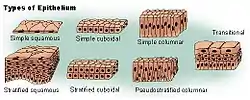Stratified columnar epithelium
Stratified columnar epithelium is a rare type of epithelial tissue composed of column-shaped cells arranged in multiple layers. It is found in the conjunctiva, pharynx, anus, and male urethra.
| Stratified columnar epithelium | |
|---|---|
 | |
| Details | |
| Shape | Many layers of flat cells |
| Identifiers | |
| TH | H2.00.02.0.02032 |
| FMA | 45564 |
| Anatomical terms of microanatomy | |
 |
| This article is part of a series on |
| Epithelia |
|---|
| Squamous epithelial cell |
| Columnar epithelial cell |
| Cuboidal epithelial cell |
| Specialised epithelia |
|
| Other |
Location
Stratified columnar epithelia are found in a variety of locations, including:
- parts of the conjunctiva of the eye[1][2]
- parts of the pharynx[3]
- anus[3][4]
- uterus
- male urethra and vas deferens[3][5]
- lobar ducts in the salivary glands
Embryology
Stratified columnar epithelium is initially present in parts of the gastrointestinal tract in utero, before being replaced with other types of epithelium. For example, by 8 weeks, it covers the lining of the stomach.[6][7] By 17 weeks, it is replaced by simple columnar epithelium.[6] This is also found in the fetal esophagus.[7]
Function
The cells function in secretion and protection.
See also
References
- Soni, Vandana; Pandey, Vikas; Tiwari, Rahul; Asati, Saket; Tekade, Rakesh K. (2019-01-01), Tekade, Rakesh K. (ed.), "Chapter 13 - Design and Evaluation of Ophthalmic Delivery Formulations", Basic Fundamentals of Drug Delivery, Advances in Pharmaceutical Product Development and Research, Academic Press, pp. 473–538, doi:10.1016/b978-0-12-817909-3.00013-3, ISBN 978-0-12-817909-3, retrieved 2020-11-29
- Forrester, John V.; Dick, Andrew D.; McMenamin, Paul G.; Roberts, Fiona; Pearlman, Eric (2016-01-01), Forrester, John V.; Dick, Andrew D.; McMenamin, Paul G.; Roberts, Fiona (eds.), "Chapter 1 - Anatomy of the eye and orbit", The Eye (Fourth Edition), W.B. Saunders, pp. 1–102.e2, doi:10.1016/b978-0-7020-5554-6.00001-0, ISBN 978-0-7020-5554-6, retrieved 2020-11-29
- Cadwell, K.; Marchiando, A. M. (2016-01-01), "Function of Epithelial Barriers", in Bradshaw, Ralph A.; Stahl, Philip D. (eds.), Encyclopedia of Cell Biology, Waltham: Academic Press, pp. 687–694, doi:10.1016/b978-0-12-394447-4.30104-3, ISBN 978-0-12-394796-3, retrieved 2020-11-29
- Gordon, Philip H. (2005-01-01), Fazio, Victor W.; Church, James M.; Delaney, Conor P. (eds.), "Anatomy and Physiology of the Anorectum", Current Therapy in Colon and Rectal Surgery (Second Edition), Philadelphia: Mosby, pp. 1–9, doi:10.1016/b978-1-55664-480-1.50006-x, ISBN 978-1-55664-480-1, retrieved 2020-11-29
- Johnson, L.; Welsh, T. H.; Curley, K. O.; Johnston, C. E. (2010-01-01), McQueen, Charlene A. (ed.), "11.02 - Anatomy and Physiology of the Male Reproductive System and Potential Targets of Toxicants", Comprehensive Toxicology (Second Edition), Oxford: Elsevier, pp. 5–59, doi:10.1016/b978-0-08-046884-6.01102-7, ISBN 978-0-08-046884-6, retrieved 2020-11-29
- Chandrasoma, Parakrama T.; DeMeester, Tom R. (2006-01-01), Chandrasoma, Parakrama T.; DeMeester, Tom R. (eds.), "CHAPTER 3 - Fetal Development of the Esophagus and Stomach", GERD, Burlington: Academic Press, pp. 41–63, doi:10.1016/b978-012369416-4/50003-0, ISBN 978-0-12-369416-4, retrieved 2020-11-29
- Chandrasoma, Parakrama T. (2018), "Molecular Evolution of Esophageal Epithelial Metaplasia", GERD, Elsevier, pp. 457–478, doi:10.1016/b978-0-12-809855-4.00015-4, ISBN 978-0-12-809855-4, retrieved 2020-11-29
External links
- Anatomy Atlases - Microscopic Anatomy, plate 02.23 – "Stratified Columnar Epithelium"
This article is issued from Wikipedia. The text is licensed under Creative Commons - Attribution - Sharealike. Additional terms may apply for the media files.